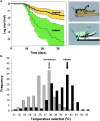Coping with crowds: density-dependent disease resistance in desert locusts
- PMID: 11960003
- PMCID: PMC122793
- DOI: 10.1073/pnas.082461999
Coping with crowds: density-dependent disease resistance in desert locusts
Abstract
Parasite transmission generally exhibits some form of positive density dependence. Thus, as population density increases, so too does the per capita risk of becoming infected. Under such circumstances, natural selection should favor individuals that use cues associated with population density to determine the optimal allocation of resources to disease resistance mechanisms. As a consequence, individuals experiencing crowded conditions are predicted to be more resistant to parasites and pathogens than those experiencing low-density conditions. This phenomenon (termed "density-dependent prophylaxis") [Wilson, K. & Reeson, A. F. (1998) Ecol. Entomol. 23, 100-101] is predicted to be particularly prevalent in outbreak pest species and in species exhibiting density-dependent phase polyphenism, such as the desert locust, Schistocerca gregaria. Here we show that, as predicted, desert locusts reared under crowded conditions are significantly more resistant than solitary locusts to the entomopathogenic fungus, Metarhizium anisopliae var. acridum, a key natural disease of acridids and an important agent in locust and grasshopper biocontrol. Moreover, enhanced pathogen resistance in crowded locusts is associated with elevated antimicrobial activity, but not with any difference in thermal preferences or behavioral fever response. These results have implications for understanding the development and biocontrol of locust plagues.
Figures

Similar articles
-
Altered immunity in crowded locust reduced fungal (Metarhizium anisopliae) pathogenesis.PLoS Pathog. 2013 Jan;9(1):e1003102. doi: 10.1371/journal.ppat.1003102. Epub 2013 Jan 10. PLoS Pathog. 2013. PMID: 23326229 Free PMC article.
-
Non-swarming grasshoppers exhibit density-dependent phenotypic plasticity reminiscent of swarming locusts.J Insect Physiol. 2013 Nov;59(11):1151-9. doi: 10.1016/j.jinsphys.2013.08.017. Epub 2013 Sep 11. J Insect Physiol. 2013. PMID: 24035748
-
Interaction between Paranosema locustae and Metarhizium anisopliae var. acridum, two pathogens of the desert locust, Schistocerca gregaria under laboratory conditions.J Invertebr Pathol. 2008 Mar;97(3):203-10. doi: 10.1016/j.jip.2007.10.002. Epub 2007 Oct 10. J Invertebr Pathol. 2008. PMID: 18005982
-
Maternal effects on phase characteristics in the desert locust, Schistocerca gregaria: a review of current understanding.J Insect Physiol. 2007 Sep;53(9):869-76. doi: 10.1016/j.jinsphys.2007.05.011. Epub 2007 Jun 7. J Insect Physiol. 2007. PMID: 17624367 Review.
-
Chemical ecology of locusts and related acridids.Annu Rev Entomol. 2005;50:223-45. doi: 10.1146/annurev.ento.50.071803.130345. Annu Rev Entomol. 2005. PMID: 15355238 Review.
Cited by
-
Altered immunity in crowded locust reduced fungal (Metarhizium anisopliae) pathogenesis.PLoS Pathog. 2013 Jan;9(1):e1003102. doi: 10.1371/journal.ppat.1003102. Epub 2013 Jan 10. PLoS Pathog. 2013. PMID: 23326229 Free PMC article.
-
Microarray-based transcriptomic analysis of differences between long-term gregarious and solitarious desert locusts.PLoS One. 2011;6(11):e28110. doi: 10.1371/journal.pone.0028110. Epub 2011 Nov 23. PLoS One. 2011. PMID: 22132225 Free PMC article.
-
Variation of TNF modulates cellular immunity of gregarious and solitary locusts against fungal pathogen Metarhizium anisopliae.Proc Natl Acad Sci U S A. 2022 Feb 8;119(6):e2120835119. doi: 10.1073/pnas.2120835119. Proc Natl Acad Sci U S A. 2022. PMID: 35110413 Free PMC article.
-
Flexible diet choice offsets protein costs of pathogen resistance in a caterpillar.Proc Biol Sci. 2006 Apr 7;273(1588):823-9. doi: 10.1098/rspb.2005.3385. Proc Biol Sci. 2006. PMID: 16618675 Free PMC article.
-
Population Density-Dependent Developmental Regulation in Migratory Locust.Insects. 2024 Jun 11;15(6):443. doi: 10.3390/insects15060443. Insects. 2024. PMID: 38921158 Free PMC article.
References
-
- Steinhaus E. Ecology. 1958;39:503–514.
-
- Steinhaus E. Insect Pathology. New York: Academic; 1963.
-
- Wilson K, Reeson A F. Ecol Entomol. 1998;23:100–101.
-
- Boots M, Begon M. Funct Ecol. 1993;7:528–534.
-
- Kraaijeveld A R, Godfray H C J. Nature (London) 1997;389:278–280. - PubMed
Publication types
MeSH terms
LinkOut - more resources
Full Text Sources
Research Materials

